Product descriptions inform so much of a consumer’s purchasing decisions. Don’t believe me? Convertcart reports that 87% of shoppers will not buy from a company again if they use inaccurate descriptions.
That’s pretty much as cut and dried as it gets. If you write accurate product descriptions, your eCommerce business can collect more sales, convert more leads, and drive your business forward.
However, what is a good product description? What separates the best ones from the descriptions that are simply mediocre and inspire abandoned carts?
In this blog post, we’ll share top actionable tips, best practices, and unique insights into creating winning product descriptions.
Table of Contents
Key Takeaways
- Writing product descriptions that convert requires you to know your audience, write with passion and authenticity, optimize your content for SEO, and add visual elements like videos and images.
- The next step in producing better descriptions is audience research, followed by drafting a few descriptions according to the guidance in this post.
Understanding the Basics
I like to start with a good foundation to ensure you understand what you’re getting into, as that can help you write a great description when the time comes.
Product descriptions 101
A product description is self-explanatory. It’s a blurb, usually of up to 300 words, that describes your product, what it does, how it works, and why you should buy it.
It sounds simple, but there’s a difference between writing technical jargon no one understands (or cares about) and writing in an engaging way that draws people in and keeps them reading. You’ll master that difference by the time you’re done here today.
Why product descriptions matter
A solid product description is the difference between a website visitor purchasing your products and not.
It’s your opportunity to sell to the prospective customer. By telling them why they need your product and how it will enrich their lives, they should hopefully feel inspired to purchase immediately.
Thus, product descriptions influence your conversion rate. If you spot a lot of abandoned carts, you have about a billion different areas you can check, from your marketing to your website design and sales message, but don’t forget to review your descriptions. They could use some optimization.
Speaking of optimization, well-put-together descriptions also positively influence SEO. Inserting the keywords you’ve researched naturally into the content will signal search engines to rank you for that term.
Read more: Customer Profile — How to Create One Using CRM Software
Key Elements of a Great Product Description
Let’s dive into the many elements required to make your product descriptions shine.
Target audience identification
You’ve got to know who you’re writing for. And no, the answer isn’t search engines, even if you want a high rank. It’s people.
However, not just any people. You need to dig into your audience’s pain points, opinions, needs, beliefs, and budget to determine who among them are the most viable candidates to purchase your product.
Those are the people you need to write for. Build a customer avatar or persona to put a face and name on this group, then write with that person in mind.
Features
At the very least, your description needs to discuss what your product is and what it does. You can also use the features section to explain how it works.
Despite this straightforward information, now is not the time for a boring, formulaic copy. You must keep the entire description engaging if you want people to read to the end.
Benefits
Here is the real star of your product description. Your reader knows what the product does by now, but why do they need it? This is what the benefits section is all about.
As you describe a feature, you can naturally attach a benefit to it.
For example, if you sell a vacuum cleaner with a pet hair nozzle, the benefit is no more pet hair floating around the house and getting on your clothes and furniture.
Tone and branding
Your product description must be branded, as that’s part of what makes it unique (you know, besides your products). That means using the right tone.
You should have already identified your brand tone, but if you haven’t, here are some directions to take it:
- Formal
- Authoritative
- Funny
- Friendly
- Informative
- Optimistic
- Mysterious
- Professional
- Informal
- Straightforward
- Heroic
- Conversational
- Down-to-earth
- Dry
- Sympathetic
Besides your brand voice, the graphics used on your page should also be branded. That means including your brand logo and colors. If you have a catchphrase or saying, that should also go into your description.
Branding consistency is important in establishing and strengthening your brand in people’s minds, so if you have multiple people on your team, they must be aware of your brand. A brand guide could be helpful here.
Read more: 9 Types of Branding And What They Really Mean
Brevity
Remember, there’s no need for your description to exceed 300 words. At some point, you have to let your products speak for themselves. Consider adding an explainer video if your descriptions are too long and you aren’t sure what to cut out.
Visual media
Your product description requires visual media to sell your product. At the very least, you need images of the product in question, but videos are also beneficial. After all, almost half of internet users will look for a product video before they buy.
The visual media included on your product page should be high-res but compressed enough that it improves the loading speed of your site (more on that later when I talk about SEO optimization for product pages).
Images and videos should show your product from various angles and, in the case of videos, how the product is used. This proves that anyone can pick up and use your product and begin benefitting from it immediately.
Read also: A Complete eCommerce SEO Guide for Beginners
SEO Best Practices for Product Descriptions
What kinds of keywords do you use in your product pages? How you answer that question could be the difference between ranking well or landing on the second page of results, where you’re practically invisible.
Search engine results are not random. Crawlers for Google and other search engines will review various criteria to determine your rank, one of which is keyword usage and the other of which is metadata.
I’ll explain both so you can optimize your product pages for better SEO rankings.
Keyword research and placement
The keywords you target can influence where your eCommerce store website ranks, so you can’t choose just any term. You need to find the terms your audience is looking for, which means starting with keyword research.
Tools like Google Trends, Ahrefs, SEMrush, and Google Keyword Planner can help you discover relevant terms your audience searches for. As you begin unearthing keywords, you’ll notice that some have higher difficulty than others.
Keyword difficulty refers to how much search volume a term gets. A high-difficulty term with a difficulty score of 61% to 100% has a lot of steep competition. That can make it tougher for a newer eCommerce site like yours to rank well for that term.
While low-difficulty terms between 0% and 30% might seem the right answer, they aren’t always. These terms are sometimes bereft of competition because no one searches for them.
Instead, aim for terms with a medium difficulty between 31% and 60%. These keywords have some competition but not so much that it’s insurmountable for a small eCommerce store like yourself to break in.
Once you’ve identified the right keywords to target, you have to place them properly. So, where do they go? Here are some places for your terms:
- Page title
- URL
- Meta descriptions
- In the body content, especially within the first 200 words
- Alt tags
It would be best if you didn’t use your keywords excessively, as that’s known as keyword stuffing. Search engines penalize that behavior rather than reward it. When adding keywords to the body copy especially, you should only use them in a product description once or twice, tops.
Meta descriptions
A meta description is a short, succinct overview of your product within 150 and 160 characters. While you can use AI to generate them, they don’t always come out as good as needed. You’ll probably have to improve the content a little.
A good meta description uses your keyword and motivates people to keep reading.
Read more: eCommerce Marketing — 8 Fantastic Strategies for Success
Writing Techniques for Engaging Descriptions
By now, you’ve got the bones of your product description ready to go. Now, you need to make it appealing so your audience can’t wait to learn more about your products. That involves using these techniques.
Storytelling
Every brand is unique, meaning it has a special story. Product descriptions allow you to share your story, draw people in, and inspire them to try your brand.
Weaving a narrative into your product descriptions should always make the customer the hero of the story with your business as a helpful guide to get them the results they want.
Sensory words
The trouble with online shopping is that people can’t hold a product in their hands, feel its weight, and see its shine. They can’t rub their fingers over its texture and turn it on. They have to rely on videos and images.
Incorporating sensory words into your product description is like putting the product in the prospective customer’s hands. That, combined with AR “try before you buy” previews, will help them make a purchasing decision they can feel confident and proud of.
What kinds of sensory words will have the most impact? That depends on which of the senses you’re trying to invoke.
For example, if you specialize in snacks or treats, you can whet a reader’s appetite by using taste-related sensory terms like:
- Nutty
- Acidic
- Tart
- Sour
- Sweet
- Spicy
- Bitter
- Seasoned
- Crisp
- Tangy
- Fruity
- Robust
- Mature
- Hearty
- Charred
- Aged
- Creamy
And if yours is a touch-based product, use the following sensory words:
- Pillowy
- Waxy
- Stiff
- Cold
- Hot
- Springy
- Slimy
- Prickly
- Hard
- Soft
- Silky
- Impenetrable
- Rough
- Smooth
- Glossy
- Firm
- Elastic
Does your eCommerce store sell items that are known for their lovely aromas? Try the following olfactory-related sensory terms:
- Earthy
- Natural
- Powerful
- Smoky
- Minty
- Fresh
- Fruity
- Spicy
- Sweet
- Delicate
- Crisp
- Aromatic
- Citrusy
These sensory terms are related to hearing:
- Rumbling
- Thundering
- Mellow
- Buzzing
- Rhythmic
- Loud
- Quiet
- Sweet
- Pulsating
- Explosive
- Peaceful
- Humming
- Audible
Oh, and don’t forget your basic sight-related sensory words:
- Shiny
- Vast
- Elegant
- Appealing
- Minimalist
- Spacious
- Colorful
- Ornate
- Light
- Dark
- Glowing
- Bright
- Extensive
Formatting
Writing and publishing a product description aims to get people to read it and make a purchase decision. However, as good as your information is, it will not make a difference if formatted incorrectly. Your bounce rate will still be high.
So, how do you increase it? Let’s take a look!
- Use bullet points: Did you notice how this article uses bullet points to illustrate points and break up the text? Your product descriptions also need bullets, especially when covering the product features and benefits.
- Add subheads: While you don’t need too many subheads (the product description should only be 300 words, you’ll remember), one or two will keep the product page neat and your marketing copy focused.
- Whitespace is your friend: Whitespace separates elements and keeps your product page contents neat so readers can focus on the words on the page.
- Incorporate media: Media is also great for breaking up your written product copy, especially an explainer video or relevant image inserted in the right spot.
- Shorten paragraphs: A paragraph should only be three or four sentences. If yours are too long, they’ll impact readability.
Read more: Mastering Brand Storytelling — Strategies and Examples
Optimizing for Conversion
Earning conversions requires a dose of optimization, which is quite a big dose. These measures will set up your product descriptions for success.
CTAs
No product page is complete without calls to action or CTAs. Depending on length, you might implement a few text CTAs in your product description.
A CTA must be succinct and clear. The anchor text should explain what happens when the user clicks on it, such as “Check Out Our Newest Items” or “Shop the Sale NOW.”
Writing clear, straightforward CTAs like this will encourage more purchases.
Social proof
Trust is hard to come by among online shoppers, especially as a new eCommerce brand. Adding social proof to your product descriptions can give you a leg up.
If you have user-generated content or UGC, put it front and center. The same goes for testimonials and reviews. And if you don’t have any social proof yet, you need to get it first.
Contact potential buyers or those who recently purchased your product and ask if they will take five minutes to leave you a review. Offer an incentive, such as 10% off their next order.
And why does social proof matter, you ask? Well, 70% of consumers trust the opinions of their fellow strangers, and 92% trust the opinions of their friends.
In other words, there’s more trust among fellow customers than in your words as a company trying to make money. You need that social proof to signify to prospective customers that your product is worth buying.
Trust signals
You can bolster your social proof through trust signals. If your business has any relevant certifications or awards, share them above the fold. It would be best to have a clear return policy on the product page.
Does your eCommerce company offer guarantees? Put this information on the product page as well.
Mobile optimization
It shouldn’t be surprising that most consumers who connect with your page will do so through mobile. If your product pages aren’t ready to accommodate them, you will lose them, probably forever.
While mobile optimization goes beyond what’s in your product descriptions and includes the product pages, it’s still something to build into your preparation before your next promotional campaign.
Testing
While at it, be sure to A/B test your product pages before they go live. Sometimes, rearranging specific elements and making other small tweaks is all it takes for better audience reception. In other cases, you need the entire product page overhauled.
The only way to be sure is to test. Using a sample audience to gauge your page’s performance is always better than your real audience. They’ll only see the best version of your product descriptions.
Read more: Best CTA Examples for Small Businesses To Learn From
The Best Product Description Examples
I don’t know about you, but I love a good example to inspire me in a new direction. These product description examples can help your eCommerce business forge a unique path and draw an audience that’s ready to buy.
Ember
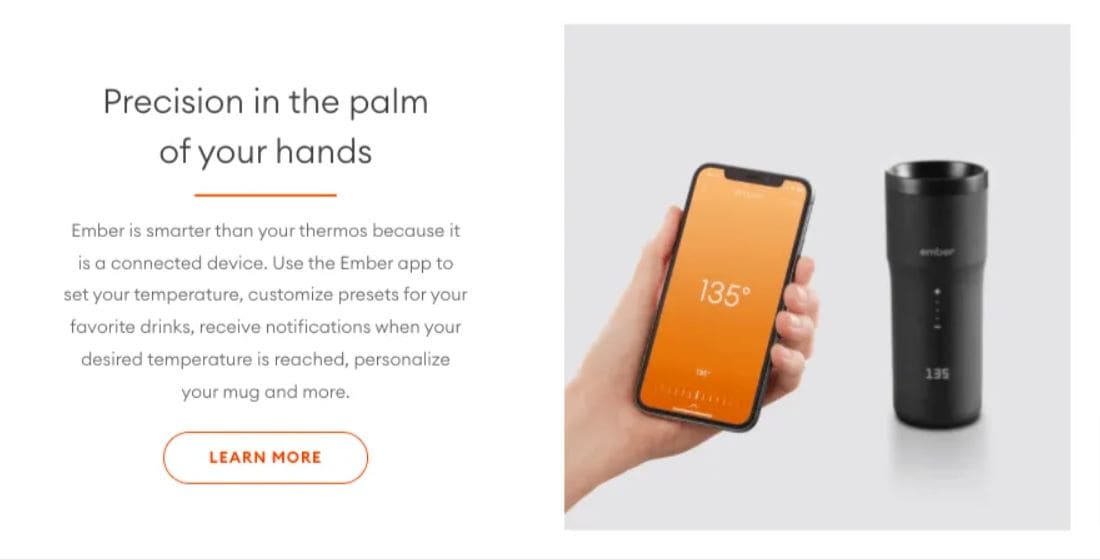
Ember thermoses and bottles have smartphone-controlled temperature options, which is awesome. Its product page, as shown above, sells the product beautifully.
The headline, “Precision in the palm of your hands,” inspires curiosity. The image to the right of the copy showing someone holding a phone and adjusting their Ember thermos temp is related to the copy.
The description is a short paragraph that uses words like “smarter,” “customize presets,” “desired temperature,” and “personalize” to inspire purchases.
The background of the product page is pure white, with an orange line separating the headline and product description. You’ll also notice the CTA button is orange, complementing the hue of the smartphone app in the photo.
Unearth Women
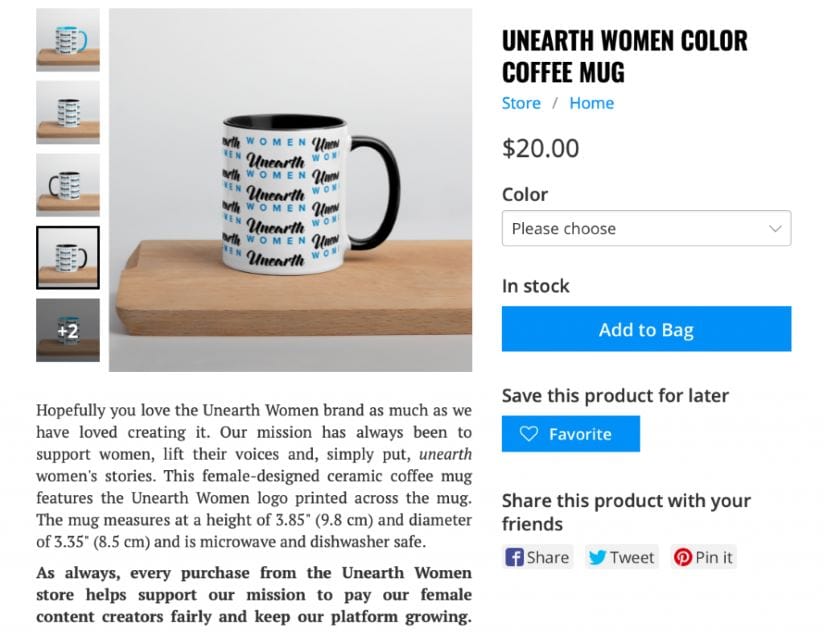
Talk about building a connection with your audience! Unearth Women takes a one-on-one approach when writing its product description, focusing on its goal of supporting women. To that end, Unearth mentions the mug is women-designed.
Below the paragraph describing the features and measurements of the mug is another shorter, bold paragraph mentioning that a customer’s purchase will help the Unearth Women platform.
The rest of the product page is simple. There is no headline used here besides the product’s name, and no videos either, only several images of the mug. Despite that, this page works excellently for its intended purpose.
Lilly’s Kitchen
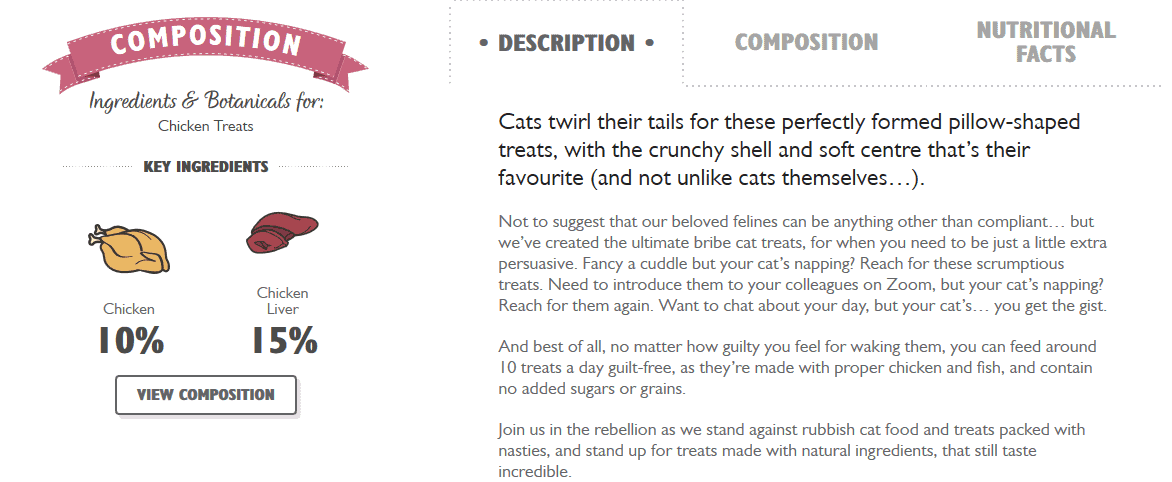
Talk about a purrfect product description! Lily’s Kitchen, specializing in pet food, sells its Chicken Treats with an awesomely written description.
Sure, it’s a touch lengthy yet never long-winded. Part of what helps is how descriptive and sensory the copy is. For example, there’s a mention of how cats “twirl their tails” and how the treats are “perfectly formed pillow-shaped…with a crunchy shell and soft center.”
The other two paragraphs are cutesy and story-driven, discussing how you can use the treats as bribe treats, such as when your kitty is napping but you want to cuddle them.
That leads to a nice tie-in about how healthy the treats are for guilt-free pet snacking.
Weber
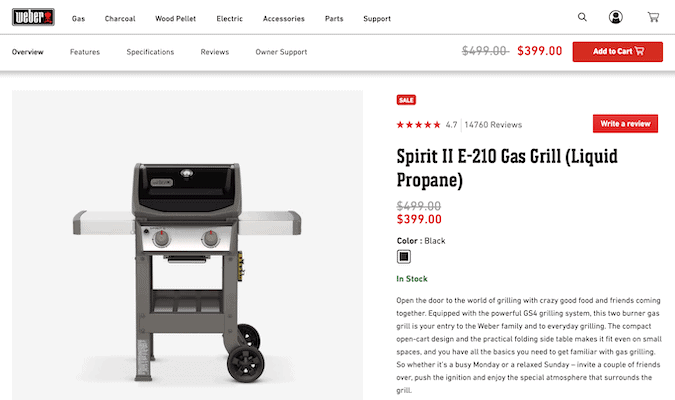
Products like grills don’t have a lot of room to let a brand’s personality shine, right? Wrong! Just ask Weber, one of the biggest names in grilling products, how to make a product description about grills personable and enjoyable to read.
I love how this product description starts with “opening the door to grilling with crazy good food and friends coming together.” That’s what grilling is all about at the end of the day, and Weber sums it up in that opener.
Naturally, with such a strong beginning, you’ll want to continue reading. The rest of the paragraph includes product details while still discussing benefits like gathering friends.
Innocent
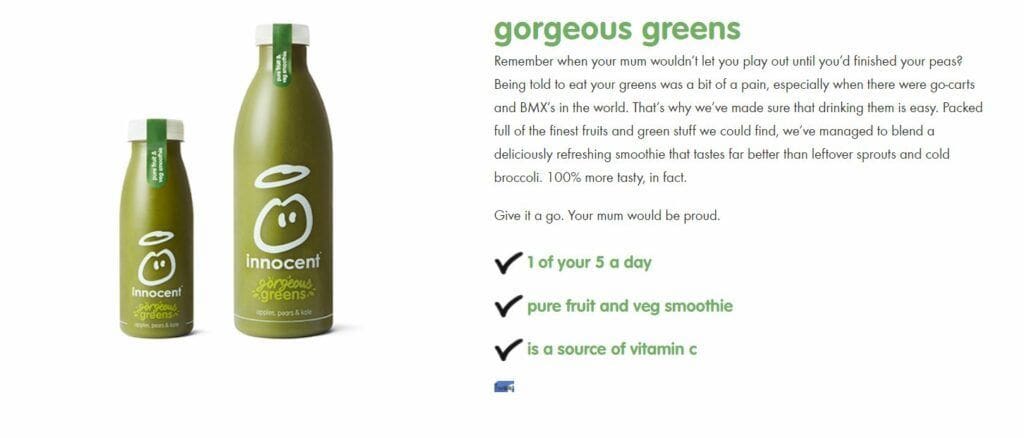
The UK drink brand Innocent knows how to write copy that converts. Look no further than this product description!
It starts by introducing a situation we can all relate to – how annoying it was to consume our greens as a kid. That intro coalesces into a product description, with Innocent focusing on how convenient it is now to get your greens on the go.
Beneath the copy are a few checkmarks mentioning how healthy the shake is, and beside that are two images of the shake. Besides some green text in the title, this product page uses a lot of whitespace.
Read also: Dropshipping Product Description Guide For Beginners
Common Mistakes to Avoid
Now you’ve gotten the hang of it, writing product descriptions should get easier with each one you do. That said, there are always mistakes to stay cognizant of and avoid. I’ve got you covered.
Here are some errors you don’t want anywhere near your product descriptions.
Overuse of jargon
Look, I get why there’s a temptation to use jargon. It makes you sound professional and like you know what you’re discussing.
However, your audience doesn’t know what you’re talking about. It’s like speaking another language.
No matter your industry, you can simplify jargon into everyday terms. Reducing the complexity ensures that prospective customers understand what you’re saying.
Ignoring mobile users
With so many people coming your way from smartphones, tablets, and the like, you can’t afford to skip mobile optimization. Your site must provide every user with a seamless loading and browsing experience, or you won’t get half the sales your products could achieve.
Duplicate content
Have you ever seen a product description that copies the manufacturer’s description verbatim? Not only are those kinds of descriptions uninteresting, but they’re also duplicate content.
Search engine crawlers don’t like duplicate content and can ding your rank if you have it.
Plus, like I said, those descriptions are dry and boring to read. They’re usually full of technical jargon and details only manufacturers care about, not consumers. Write your descriptions moving forward.
Read also: Master the Art of Copy With These Great Copywriting Examples
Tools and Resources
Improving one’s copywriting skills isn’t an overnight process. Fortunately, besides the great pointers in this guide, you have plenty of other resources at your fingertips for improving.
Copywriting tools
As a fellow copywriter, I love the Hemingway Editor. It will pick up on your spelling errors, grammar mistakes, and other gaffes in your writing so you can improve them. Best of all, you can use it for free, although the paid edition is more thorough.
I also like Grammarly, which can clean up your copy until it sparkles. Oh, and try Copyscape, too. It will comb through internet content to ensure yours is 100% original.
SEO tools
Mastering SEO is tough. The rules always change, so having a tool or two in your corner goes a long way.
To that end, you can’t go wrong with Semrush, which has a library of tools for becoming an SEO guru. Choose from:
- Technical and on-page SEO tools such as On-Page SEO Checker, Listing Management, and Site Audit.
- Keyword research tools like Organic Traffic Insights, Position Tracking, Keyword Strategy Builder, Keyword Magic, and Keyword Overview.
- Link-building tools include Bulk Analysis, Link Building Tools, Backlink Audit, and Backlink Analytics.
- Competitive research tools, including Backlink Gap, Keyword Gap, Organic Research, Traffic Analytics, and Domain Overview.
Besides Semrush, you can also try Moz, Yoast SEO, Ahrefs, and Surfer.
Learning resources
Check out the Grammarly blog and Copyhackers to learn new copywriting skills and sharpen those you already have.
Conclusion
Quality product descriptions require a continuous effort to optimize and maximize. The techniques I discussed today will put you on the right track. Once you’ve implemented them, begin monitoring your results.
Be sure to subscribe to EngageBay’s blog for more copywriting and eCommerce tips!
EngageBay is an all-in-one marketing, sales, and customer support software for small businesses, startups, and solopreneurs. You get email marketing, marketing automation, landing page and email templates, segmentation and personalization, sales pipelines, live chat, and more.
Sign up for free with EngageBay or book a demo with our experts.
Frequently Asked Questions (FAQ)
1. How long should a product description be?
The sweet spot for a product description is up to 300 words. That’s just enough space to write about the product succinctly without going overboard.
2. What are the best tools for writing product descriptions?
You can use product notes, specs, and a word-processing document or rely on AI tools or product description generators. You have plenty of options to get the ball rolling.
3. How can I make my product descriptions SEO-friendly?
Your descriptions need a good ratio of keyword usage, clear headers and subheads, and metadata to rank well.
4. Should I include technical specifications in my product descriptions?
To an extent, you can, such as measurements for a product, but don’t go too deep into the technical specs when writing your description. You will turn prospective customers away.
5. How do I write product descriptions for different target audiences?
It would be best to segment your audience first, then identify their pain points and challenges based on your research.
6. Can I use the manufacturer’s description for my products?
You can use it as a starting point, but don’t copy the manufacturer’s description verbatim. Your SEO rank could drop, and your bounce rate could increase.
7. How often should I update my product descriptions?
As often as required, such as when changing or updating your product.
8. What role do images play in product descriptions?
Well, images help the prospective customer visualize the product, for starters. Product photos also break up copy and help leads make a purchasing decision.
9. How do I write product descriptions for products with multiple variations?
Many eCommerce platforms, such as Shopify, have apps for writing descriptions for each product variant, making your life much easier.
10. What is the impact of product descriptions on conversion rates?
Product descriptions help sell a product and can inspire higher conversion rates than pages that use generic descriptions from the manufacturer.
